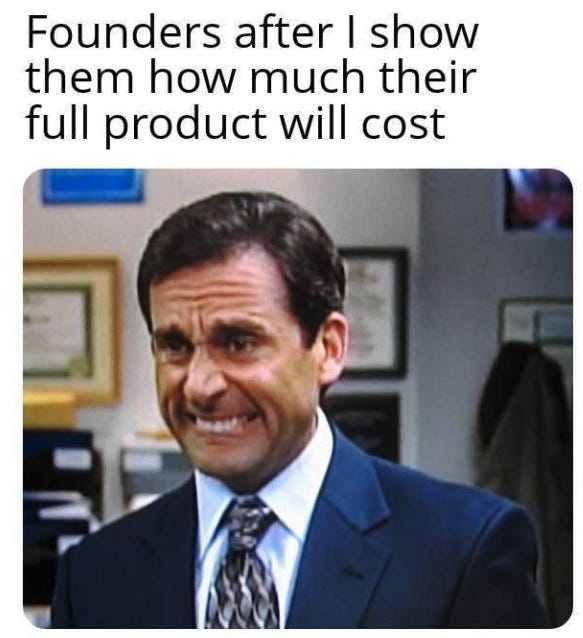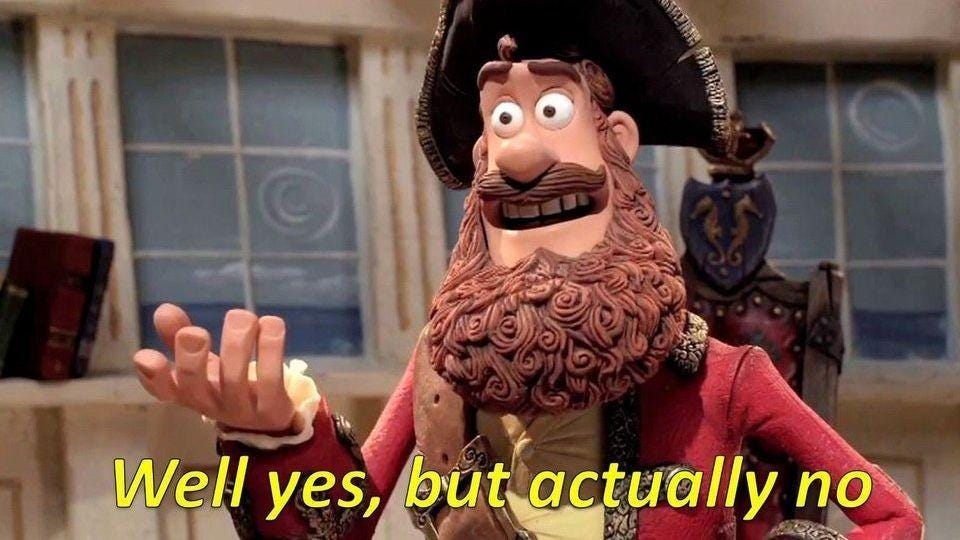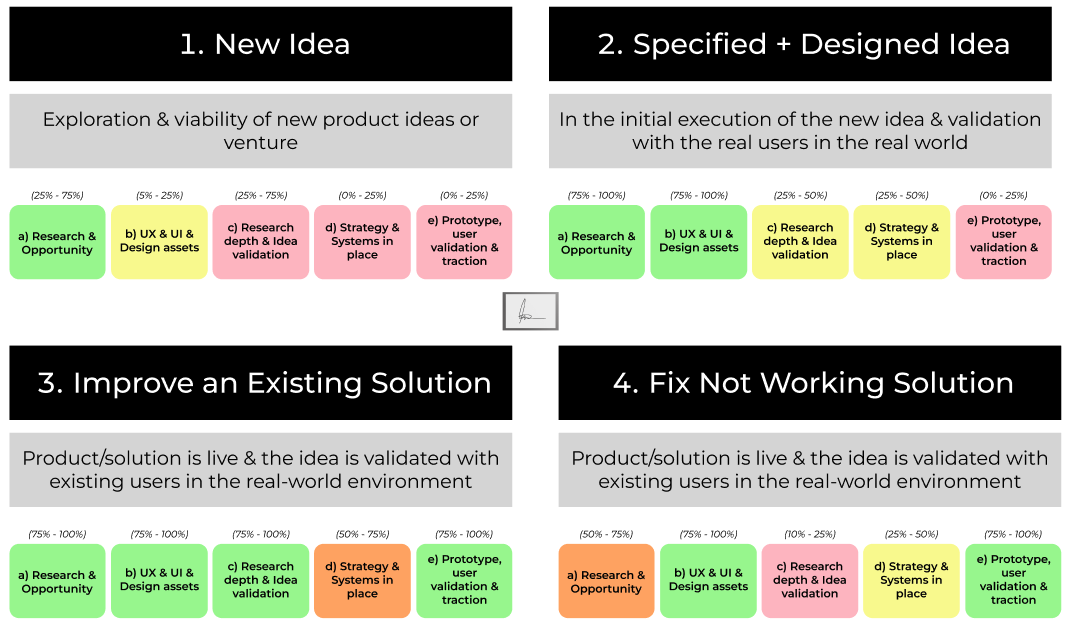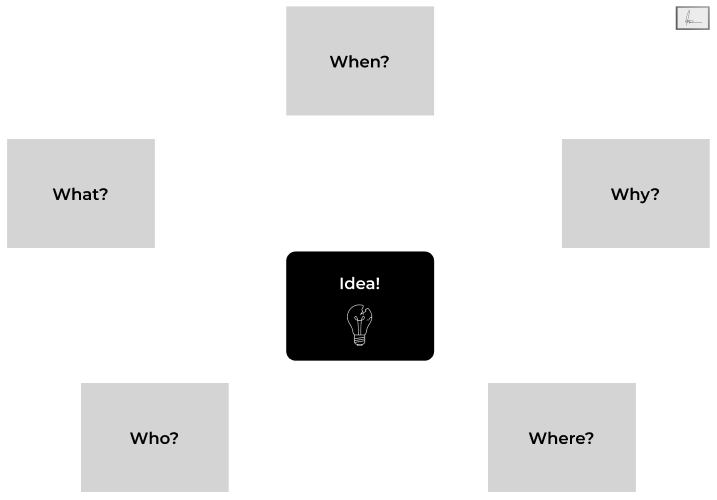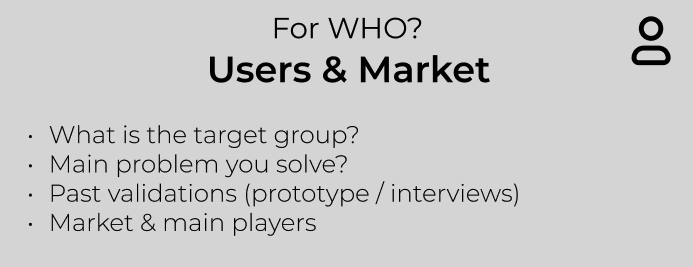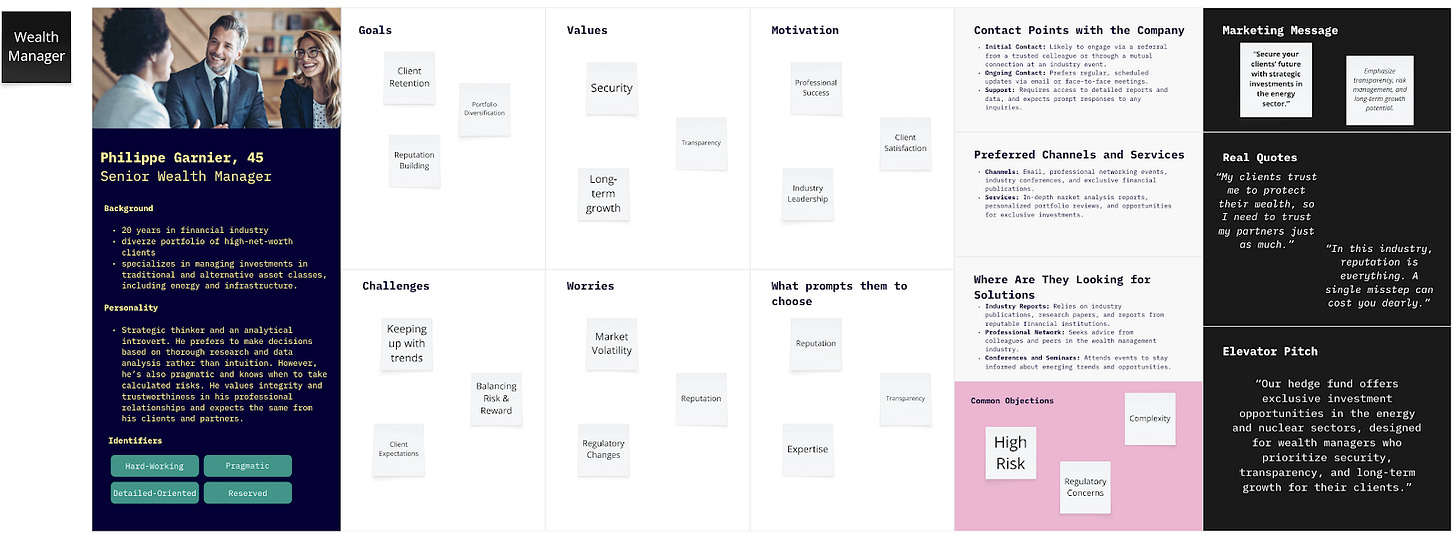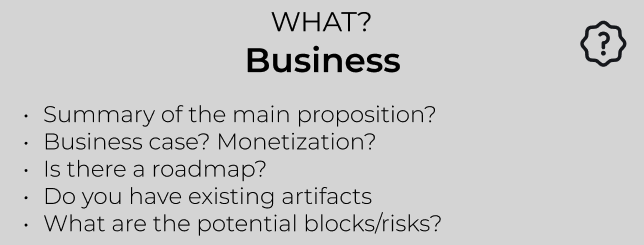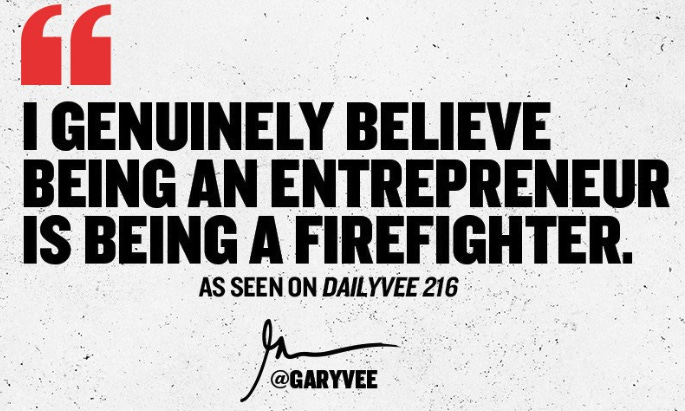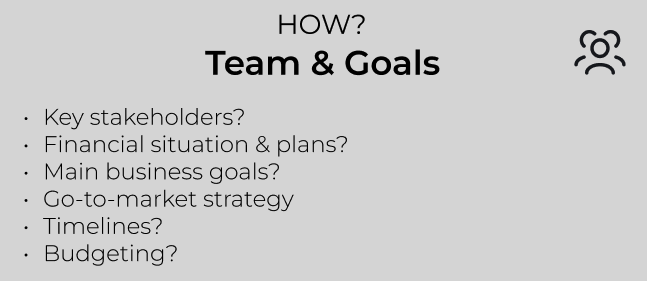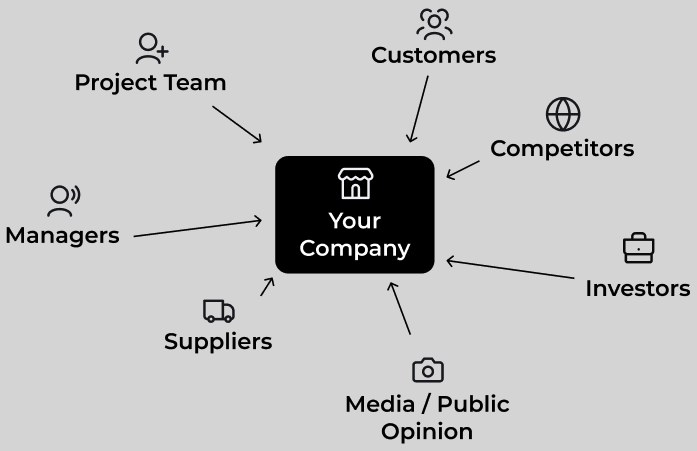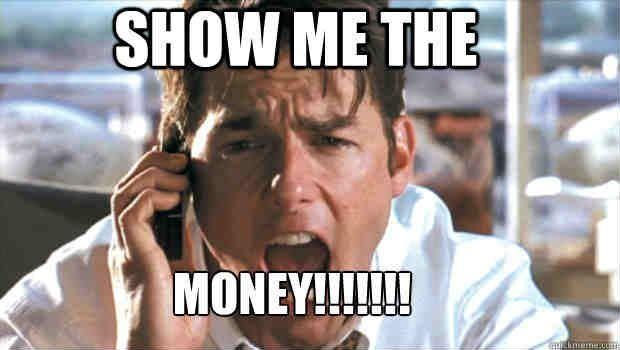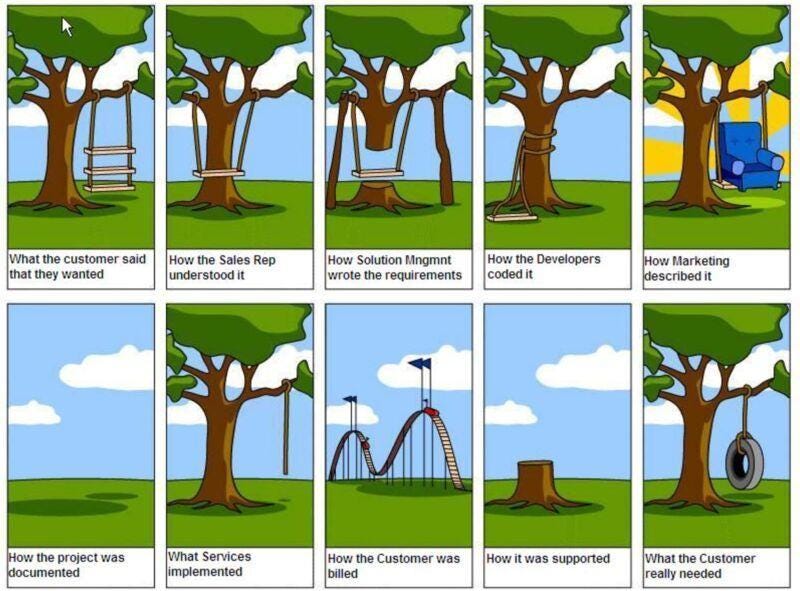How to Validate Your Idea: The Hidden Meaning Behind the Questions Professionals Use to Test Your Idea’s Success
Founders and advisors — this article will give you a fresh perspective on how to ask the right questions and, more importantly, what the hell to take away from the answers.
💡 What’s this article about? We’ll look at how to figure out whether your idea makes any damn sense — before you waste your time and money.
You’ll get a practical take on how experienced professionals assess the potential of startup ideas — not just through the usual questions, but through the hidden meaning behind them.
You’ll learn:
Why having a “good idea” means jack shit unless you know who it’s for, what problem it solves, and why someone should give a damn.
How to uncover risks in your team, product, and market before the first cent goes in.
What you can actually take away from the answers and how to turn them into a solid proposal that can convince both investors and clients.
If you’re a founder just starting out, or a pro who wants to really get the basics of idea validation right, this article gives you a new way to look at questioning — and more importantly, how to actually use the answers.
This article is largely inspired by the practices I picked up while working in agencies that have delivered dozens (if not hundreds) of successful projects. You’ll find similar methods floating around in various expert sources online — nothing top secret here.
One of the key steps before sending a proposal for collaboration with a startup is the so-called prospecting workshop. It’s a session I sometimes run with potential clients who’ve already made it through the initial approval stage with the sales team — meaning someone decided the collaboration might actually be worth it.
I’ve been working in the venture building and product development space for years, both in deal-making and hands-on delivery. In that time, I’ve created over 900 presentations, beaten out firms like BCG and McKinsey, closed deals worth millions with major corporates and market leaders, and also worked with smaller businesses in the tens of thousands range. These days, I focus mostly on startups.
If you want to understand the difference between building ventures and building products, I recommend checking out my other article: How to Build a Startup, Product, or Innovation.
The main difference in preparing proposals for small startups vs. big corporates lies in the completely opposite approach.
With corporates, you have to cover everything: break down each phase, outline concrete steps, build a budget, test feasibility, define the team and timeline. Classic waterfall.
When I tried to apply that same method to startups, I hit a brick wall. Startups often operate with tight budgets and a whole lot of uncertainty. If a founder shows up with big dreams, you price out the project, and the total makes them choke — the deal’s dead before it even started.
Corporates typically know what they want to build — it’s not revolutionary, it’s supporting their core business. But with startups? You’re dealing with wild uncertainty and a wallet full of air.
So while I try to get as much info as possible during prospecting workshops to build the best proposal for corporates, with startups, it’s a different beast. You need a much deeper dive into the risks and a realistic plan to minimize them.
This seemingly small difference turned out to be a total game-changer for me — it completely flipped how I work. Thanks to this shift, I went from closing one deal every three months to sealing five out of six in a single month.
So, what can you take away from this for your own business?
For every workshop like this, I use a set of core questions I ask startup founders or anyone planning a new startup or product.
At first glance, these questions might seem pretty basic — nothing you couldn’t get from ChatGPT with the right prompt.
But the real value lies in what you’re trying to uncover and how you deal with the answers.
That’s exactly where I noticed the biggest gap when some of my colleagues tried running prospecting workshops or writing proposals themselves.
Even though they asked the same questions, they couldn’t extract enough meaningful information to create a solid proposal or close the deal.
So let’s break it down and show you how it’s really done.
Questions to Validate Your Idea (and What They Actually Reveal)
Before we dive into the specific questions, I always kick off a workshop with a general intro: we introduce our company and ask the client to introduce themselves.
The General Introduction
Everyone — whether it’s clients or folks without much experience in this field — seems to think that introducing the project, the founding story, or the background of the founders is just about breaking the ice or giving them a chance to tell their story.
And sure, that’s true… but only about 30% true.
The real reason? It gives us the first glimpse into founder risk — whether this person is actually capable of making the idea successful, and also what kind of risks we’d be taking by working with them in the first place.
Let’s get into the specific questions and what they really tell us.
“What’s your story — and the story of your product?”
This is one of the most crucial questions in the whole process. And easily one of the most underestimated.
The Story of You and Your Co-Founders
Let me try to put this in a way that doesn’t sound like a total dick move.
When I ask this question, most people think I’m dying to hear their entire life story — how they met their co-founders, what inspired them, where they came from, the whole origin myth.
That’s… maybe 30% of what I care about.
Sure, it’s a nice opener, it builds rapport, it makes everyone feel comfortable. But the real reason I ask is this:
It helps me immediately identify one of the biggest risks in the whole project — the Founder Risk.
(If you want a deep dive on that, check out my series on risk analysis.)
Founder risk is basically about how equipped the founders are — in skills, experience, and mindset — to pull this thing off. And that shapes everything: from our collaboration model to the level of support or hand-holding required.
I once had a conversation with the founder of a legal firm we work with — Sparring — which also advises U.S. startups. He told me that one of the top reasons startups fall apart is friction or dysfunction between co-founders. And I believe that 100%.
So what am I actually trying to find out with this question?
What skills do the founders bring to the table?
Do they have domain knowledge or relevant experience?
Are they complementary — like the golden combo of a product person and a developer?
If they lack technical know-how, do they have any unfair advantage?
By unfair advantage, I mean something that sets them apart in a major way — being an insanely good salesperson, having loads of capital, a killer network, deep industry insight, or previous exits under their belt.
You’ve got to do a brutally honest self-assessment — and let’s be real, most people can’t do that. That’s why founders often pay for business consultants or coaches, even just short-term. I do too. Especially founders who’ve had success elsewhere — they tend to be overconfident and blind to reality.
Let me be concrete.
Some of my good friends — at least three of them — came from what I call “old-school” businesses. One ran a car repair shop, another sold herbs, and another traded trucks. All of them thought they could waltz into the digital product space (aka my world) because they had money and some past success.
Guess what? I warned them, they didn’t listen — and every single one of those businesses tanked.
If you lack core experience in the space you’re entering, you’d better be damn sure you can compensate for it somehow — and more importantly, whether that compensation is sustainable.
You can throw money at a problem for a while — until the money runs out.
You can lean on your network — until the network dries up or stops calling back.
“Only when the tide goes out do you discover who’s been swimming naked.”
— Warren Buffet
So that’s the first layer of the question — figuring out who the hell you are and what kind of chemistry your team has.
The Story of Your Product
Now let’s look at the second layer — the story behind your product.
When you work in consulting, you need to have a broad scope and experience in many fields. Which means it’s not always easy to tell right away if a new idea is solid or completely idiotic.
Unless it’s some next-level nonsense — but those folks usually don’t make it to us. They go straight to accelerators.
So what I’m really trying to understand here is how you got to this idea and how well you understand what’s called the problem space.
Do you really get the problem you’re solving?
Do you actually know the customers who have this problem?
Maybe you’re founders who were on a trip together and stumbled upon a pain point nobody’s solving. Or maybe you’re seasoned experts in a niche industry and you’ve built something that addresses a gaping need in that space.
Look, anyone can succeed. But in the first scenario, I know we’ll need a much longer and more detailed research phase compared to the second one.
This opening question — “What’s your story?” — is, in my opinion, one of the most important and most underrated questions in the whole damn process.
So now let’s move on to the actual list of questions you can ask yourself — to validate your idea or, at the very least, show up to meetings actually prepared.
Specific Product Questions
Before we dive into idea-specific questions, we always start by defining what type of idea we’re dealing with. In most cases, a startup falls into one of these categories:
A brand new product idea
A defined and designed concept
An improvement to an existing solution
A fix or rescue mission for something that’s not working
Sure, you can slice this into more categories if you want, but at the end of the day, we’re trying to gauge how far along the founder actually is. These four buckets give us a quick and clear sense of that.
Here’s a rough orientation table.
(yeah, it’s based on approximation derived from experience, not a PhD-level model — but it works)
But for now, we’ll focus only on the first category — new ideas. The others come with more specific, tailored questions, depending on the product’s maturity.
The questions below are grouped using the classic 5 W’s framework (Who, What, Where, When, Why — and eventually How, which we usually handle ourselves).
Let’s be clear:
This article is not about giving you the perfect strategies or templates for answering these questions. You can Google that. Or ask ChatGPT.
What we’ll look at instead is what these questions are really trying to uncover, the hidden meanings, and the red flags hiding between the lines.
Who – Your Users & Market
Who’s your target audience?
If you don’t know who you’re selling to or what motivates them to buy, don’t bother moving forward.
This question isn’t about crafting a 20-page user persona with psychographic breakdowns and pretty slides. It’s about showing how well you actually understand your users.
In early-stage projects, we often started with just one shared motivation — and only then developed profiles or personas.
Let’s say you’re building an app that delivers alcohol and pizza. Your target audience might be people who party at home and drink their own booze. That’s more useful than saying “males aged 16–24, two dogs, high school diploma, watches Marvel films” (yes, 16 — this is Slovakia, after all).
Detailed personas come in handy later — when you’re adding features, scaling, or targeting more precisely.
At this stage, it’s about listening to customers. Sometimes, that means scheduling founder interviews or planning deeper user research.
What user problem are you solving?
Even if you know your user, are you solving a real problem?
Is it painful enough to make them ditch whatever they’re using today and switch to your solution?
You’d be surprised how many people are so in love with their idea that they stop seeing the obvious.
If that weren’t the case, we wouldn’t have millions burned on stuff nobody asked for.
I’ve been there too. One of my projects had a clear user base, but I couldn’t clearly articulate what problem we were solving. There was demand, sure, but we couldn’t explain why we were better than the competition. After a bunch of hand-wavy answers, I had to go back and redefine the problem.
This is even more critical in industries with tons of competitors.
People often confuse “problems” with mild discomforts or inconvenient experiences. Like Juicero — a $400+ juicer that literally just squeezed pre-packaged fruit bags. Eventually, people realized they could just do it by hand. It solved a problem nobody had.
Another great example:
At a previous company, we had a “Head of Innovation” who loved to call himself a visionary. He always had some absurd idea floating around.
We were preparing a proposal for one of the world’s biggest flight retailers, focused on financial tools for their current users. Our “visionary” pitched a super-app — like China’s WeChat — but for travel.
Here’s what I learned:
The Western world doesn’t want super apps.
Even though people complain about having too many apps, our mindset just isn’t wired for “one app to rule them all.” We reject it.
I even asked ChatGPT to analyze it: companies like Facebook, Revolut, Snapchat, Uber, PayPal — they all tried to become super apps. Didn’t work. In the West, people want apps for one thing, not everything.
Moral of the story:
Sometimes you think you’re solving a massive problem — but you’re actually solving a problem no one gives a shit about.
Have you validated it yet? (Prototypes / Interviews)
There are plenty of cheap, effective ways to validate your idea — especially for anything short of deep tech.
You can talk to experts, show rough concepts, or even get Letters of Intent from potential customers — basically saying, “If you build it, we’ll try it.”
Even if you can’t validate a prototype, you can validate the idea and its execution path.
This question also tells me whether someone’s actually ready to play in the cold, harsh startup world.
Everyone — including me — has once made something, asked a few friends for feedback, gotten validation, and then jumped right into building.
That’s the trap.
Most people validate with a few buddies and avoid real market confrontation.
So this isn’t just about testing your idea — it tells me:
How resourceful you are
How creative you get with limited resources
How seriously you’re approaching this whole thing
It also shows your soft skills — like persistence, communication, and adaptability. All of which are make-or-break for founders.
Market Environment
When I ask about your market and competitors, I’m not looking for a textbook analysis.
You can Google the frameworks.
What I care about is:
Do you know the space you’re operating in?
Can you navigate it smartly?
How different is your solution, really?
Unless your product is 8–10x better than the current standard, users won’t bother switching.
2–3x better won’t cut it — no matter how great you think your UX is.
And when I say “navigate the market,” I don’t just mean understanding your direct competitors. That’s just the surface.
Take Uber, for example. Their competition isn’t just taxis or public transport.
It’s Netflix — because Netflix wants people to stay home.
Uber wants them to go out.
So yeah, sometimes your competitors are companies pushing completely opposite behaviors. If you understand that, you can be way more creative in your positioning.
Final Thoughts on the “Who” Section
We’ve gone deep on the first part of the question set and shown how to approach these topics from angles most people don’t even think about.
My goal is to push new founders to go deeper — and challenge experienced folks to look from a fresh perspective.
Now let’s move on to the next section: What – The Product Itself.
What – The Business Side
This part is all about one thing:
Does your project make sense in the real world?
We’re not just looking for clever ideas here — we’re checking whether the thing you want to build actually holds water from a practical and pragmatic perspective.
What’s your main value proposition?
I’m not asking what problem you’re solving — I’m asking what value you’re bringing to your customer. And whether that value is good enough and different enough to make anyone give a damn.
Take travel, for example. People want to get to another country quickly and safely. That’s the problem. But there are countless ways to solve it.
Your value proposition is your North Star — it keeps you oriented. Everything you do flows from it. It’s the sentence you’ll repeat to partners, investors, your team… and your grandma.
And that’s a good test:
If your grandma doesn’t get what you do, it’s not clear enough.
When I ask this, most people either give me an overly complex explanation or start listing every problem they think they’re solving. Stop.
It needs to be simple and sharp.
One of my current clients in LA is building a product around recommending places and restaurants. Super saturated market — so the proposition had to be tight.
They had limited budget, so I told them we need a sentence that hits like a mini-slogan and captures the core value. After combing through their material, we landed on:
“We make tourists feel like locals, and locals feel like tourists again.”
That sentence shaped our entire roadmap, from feature prioritization to product scope. It tells us why we exist.
What’s your business model and how will you monetize this?
Ah yes, the fan-favorite question — the one that’s killed more startup ideas than bad founders and government policy combined.
Unless you’re a government-backed institution or your dad is bankrolling your dreams, you’ll run out of money eventually — ask WeWork.
Monetization doesn’t have to be simple, but it has to be realistic.
If you’re playing the long game (like “we’ll monetize later”), fine — but you better show me case studies of companies who did the same and didn’t crash and burn.
Otherwise, you’re either delusional or onto something genius — and statistically, it’s not the second one.
Social platforms like Facebook started with zero revenue, but they had a plan. They built the audience first, then monetized through data and ads.
Let me give you a story I shared in another piece called Inversion as a Tool for Finding Customers, Markets, Solutions & a Happy Life:
We had someone pitch us an AR math game for 5th graders. Cool idea — fun, engaging, educational. But it crashed on scale:
Kids wouldn’t buy it themselves.
Schools needed curriculum alignment, which is a huge lift.
Gameplay wasn’t sticky enough to guarantee long-term usage.
Their numbers were off. When we sat down and ran the math — even optimistic projections — the market wasn’t big enough for real returns.
After a long pause, the founder asked, “So… should I just shut it down?”
We told him: the project has value, just not the kind of financial success he was imagining. And if he wanted to keep going, he’d better keep his burn rate under a microscope.
Bottom line:
You don’t need a 20-page business case, but you need to know where the money comes from — directly or indirectly.
Do you have a rough idea of the product scope?
Now we’re getting practical.
How much have you actually thought through — piece by piece — in terms of what you’re building?
Here’s where most founders fall flat:
They want too much, too fast, with too little time and money.
And most are scared to release a basic version of their product, afraid it’ll look “unfinished” or “embarrassing”.
Been there myself. Everyone has that fear. But you’ve got to work through it.
Even seemingly simple products often turn out to be far more complex.
A while back, we entered a competition for a non-profit that wanted an app — basically a video library to support history lessons. Teachers show videos, students respond, and quizzes get added.
When I sent over the price for development, they couldn’t believe it.
“It’s just a website for uploading videos,” they said.
So I started asking:
Does it need to integrate with school systems?
How many user roles are there? Students, teachers, schools, admins?
Have you thought through access control? Can students explore freely? Can teachers access all content?
Should the platform surface content based on curriculum, topics, timelines?
These basic questions radically change scope, complexity, and cost.
What seemed like “just a video platform” suddenly wasn’t.
And that’s why having a rough product outline is critical. It helps uncover blind spots and lets us shift the conversation from dreaming to doing.
Do you have any design artifacts?
Not much to say here — I just want to know if you’ve sketched anything. Wireframes, screens, even a napkin drawing.
It’s not mandatory. But visualizing your idea helps you stay grounded in what really matters.
Are there any potential blockers or risks?
I’ve written a whole piece on how I identify risks — go read it.
But here’s the deal:
Don’t bullshit me.
I’m not your investor, your customer, or someone you’re trying to impress. I’m someone who shares responsibility for making your thing work.
So I need to know everything.
This question also tests whether you understand the risks. Not just the product risks, but the emotional and personal shit that comes with being a founder.
You’d be surprised how many people don’t want to look at the risks.
Or worse — they think saying “I’m aware of them” is enough.
They just want to talk about the fun parts.
But reality doesn’t care what you feel like discussing.
GaryVee once said, “I’m not really an entrepreneur. I’m a firefighter. I spend all day putting out fires.” That’s more accurate than most startup blogs ever will be.
Some people even think I’m overly negative when I tear into their ideas and start listing risks. Used to bother me. Now? It’s a filter. If someone can’t handle that, I want nothing to do with them.
Because they don’t understand what a consultant is for. And they’re definitely not ready to face the truth.
Here’s a line I like to keep in mind:
“Fall in love with your problems.”
That wraps up this section, focused on what the hell we’re actually building.
Next, we’ll move on to how you plan to pull it off — or better yet, whether you’re even capable of doing so.
How – Team & Goals
This section is crucial — not just for you as founders, but for us as your potential partner or agency.
As you’ve probably noticed, the further we go, the more specific and grounded the questions get.
No more philosophizing.
It’s time to test whether your project is standing on anything solid.
We don’t need to go super deep here — the goal of this article isn’t to walk you through step-by-step guides you can find all over the internet. It’s to help you see things from angles that people usually ignore or avoid.
Yeah, I still end up over-explaining. Bad habit. But let’s get into it.
Key Stakeholders
Who are all the players involved in your company?
Who makes the decisions? Who do you report to?
This is incredibly important — and most people miss it.
They focus on whoever they’re actively talking to, but if you’ve worked with corporates before, you know that’s not how the game is played.
At the end of the day, it’s all about politics and attention.
Everyone wants to be heard. Everyone wants to matter. So you need to show every stakeholder that they’re seen and accounted for.
That’s why we need a clear picture of who’s involved — even indirectly — and what their roles are. You’ll thank yourself later.
Seriously, make a mind map or flowchart of everyone who can influence your project. Sometimes, that even includes key customers.
Right now, for example, I’m dealing with the son of one of our biggest investors. He wants to be involved, and his dad wants him to learn the ropes. So I’m spending time giving him tasks and explanations — stuff I could do ten times faster myself.
This isn’t a complaint. This is the norm at higher levels.
The more experience you have, the more you learn to anticipate and navigate these dynamics.
Financial Situation & Plans
How are you funded?
Where’s the money coming from, and what are you planning to spend it on?
It’s a basic question. But it tells me two things:
Can you afford to work with us?
Do you understand what it really costs to build something?
You should have at least a basic financial plan.
If you’re doing it yourself, I recommend using this template from Slidebean.
Key Objectives — What Are You Trying to Achieve?
What are your actual goals? First, for the project. Then, for the collaboration with us.
A lot of agency partnerships fail because expectations aren’t clearly aligned from day one.
This is where you can’t be afraid to lose a deal by being honest.
I’ve been on both sides — selling and delivering. That’s why I’m brutally clear now:
I’d rather lose a client than lose my team’s energy, sanity, or money.
Be transparent about how you work. Define your goals clearly.
Adjust expectations together.
Go-To-Market Strategy
How do you plan to launch and get this thing into people’s hands?
This isn’t just about finding out your strategy — it helps us shape the MVP.
Some might say this isn’t the “right” way to think about it, and that’s fine. But if you’re building for someone else (which we often are), you have to align MVP decisions with the founder’s budget, reach, and realistic growth path.
Are you a killer salesperson who’s planning to sell it directly?
Do you have a strong following and want to go B2C with a PLG (Product-Led Growth) approach?
Are you going after enterprise deals with contracts?
All of these change what the MVP looks like.
Right now, I’m working with a team of female founders who are insanely good at marketing. Strong brand, big newsletter, lots of social traction. So our only focus is digitizing their existing services. That’s it.
We’ve put all the usual “growth” features on pause.
The only goal: get their audience (thousands of followers) to actually use the product.
We had to ditch the conventional roadmap and go with something totally different — and it worked.
No gamification, no onboarding funnels, no bells and whistles. Just a sharp focus on core value delivery.
So yeah, GTM isn’t just something you ask ChatGPT to generate.
It shapes your entire first version of the product.
What’s Your Timeline?
Of course I want to know when you want to launch. But that’s only half of it.
What I’m really looking for is:
Is there a key external event that could impact how or when we build?
Elections. Regulatory shifts. Tech releases. Behavioral trends. Anything.
Here’s an example:
We built a product to simplify a government form after new regulations hit.
The state temporarily opened up API access, so we had to act fast. It wasn’t about long-term innovation — it was about speed and execution.
In that case, the timeline was the strategy.
On the flip side, sometimes it’s dumb to build too early.
Like an app for public pools — if it takes two months to build and you start in September, guess what? You’re burning money maintaining it through the winter.
That’s why I want to know your timeline.
Not just to plan — but to help you make smart decisions based on context.
Where/How – The Tech Side of Things
Last but not least — we need to talk about how we’re going to build your idea.
In other words: what technologies are we using?
This isn’t just about cool stacks or fancy buzzwords. It’s about whether we can actually build what you’re asking for — and more importantly, whether we can build it our way.
What tech are you building your solution on?
Like I said — I need to know if you’ve already chosen a stack that matches what we can work with, or if we can build it using our standards and ecosystem.
This question isn’t loaded. There’s no hidden trap here. Just a straight-up, honest alignment check.
Do you have any preferences or constraints?
This one’s more about limitations than wish lists.
I’m trying to find out if there are any technological restrictions — direct or indirect — that we need to be aware of.
For example:
When I worked on a project in insurance and healthcare, we had to comply with HIPAA regulations.
When I was designing for a school system, we had to understand what tech they already used — and figure out how we could integrate with it without burning it all down.
This is the last question where I’m looking at the project through a pure tech lens — trying to uncover anything that could quietly blow up the whole thing later.
One of the most interesting cases?
A startup came to us with a pitch: unlocking devices like phones and laptops using brainwaves.
Because, you know — everyone’s brainwaves are unique. Biometric innovation at its finest.
On the surface, it was doable. We had the tech on both ends. Sure, it’d be expensive, but it was feasible.
Until we hit the brick wall: there’s no reliable, safe, and regulation-friendly way to transmit data from wearable devices (like headphones) to phones.
We brainstormed hacks, explored edge cases, looked at external vendors.
But the costs were insane — and the tech simply wasn’t there yet.
The project had a green light in every other area — until that.
That one thing killed the whole thing.
If this whole approach makes sense to you — or if you feel like your product, idea, or strategy is heading in the wrong direction — maybe I can help.
Let’s jump on a quick 20-minute call and bring some clarity into the chaos.
Final Words
And that’s a wrap.
I hope this article delivered what I set out to do:
Give you a clear list of questions every founder should ask themselves before launching anything.
Show you how to think about those questions from a different angle — not just the surface-level answers, but the real reasons someone like me is asking them.
Thanks for reading — and see you in the next article.
⎯ Peter




